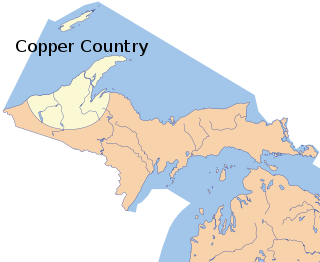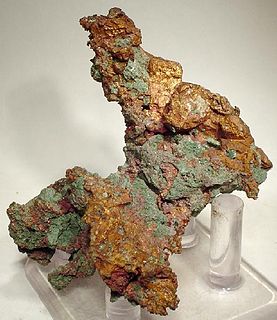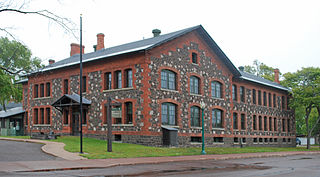Related Research Articles

Mining is the extraction of valuable minerals or other geological materials from the Earth, usually from an ore body, lode, vein, seam, reef, or placer deposit. Exploitation of these deposits for raw material is based on the economic viability of investing in the equipment, labor, and energy required to extract, refine and transport the materials found at the mine to manufacturers who can use the material.

Hancock is a city in Houghton County in the U.S. state of Michigan. It is located across the Keweenaw Waterway from the city of Houghton on the Keweenaw Peninsula. The population was 4,634 at the 2010 census. The city has been consistently ranked as the third-snowiest city in the United States by The Weather Channel.

Ahmeek is the only village in Keweenaw County in the U.S. state of Michigan. The village is located within Allouez Township, and the population was 146 at the 2010 census. At 0.07 square miles (0.18 km2), Ahmeek is the smallest village in Michigan, making it the smallest of any incorporated community in Michigan. Ahmeek is also the only incorporated community in Keweenaw County.

The Keweenaw Peninsula is the northernmost part of Michigan's Upper Peninsula. It projects into Lake Superior and was the site of the first copper boom in the United States, leading to its moniker of "Copper Country." As of the 2000 census, its population was roughly 43,200. Its major industries are now logging and tourism, as well as jobs related to Michigan Technological University and Finlandia University.

The Copper Country is an area in the Upper Peninsula of Michigan in the United States, including Keweenaw County, Michigan, Houghton, Baraga and Ontonagon counties as well as part of Marquette County. The area is so named as copper mining was prevalent there from 1845 until the late 1960s, with one mine continuing through 1995. In its heyday in the latter half of the 19th century and the early 20th century, the area was the world's greatest producer of copper.

Eagle Harbor is an unincorporated community and census-designated place located on the north side of the Keweenaw Peninsula within Eagle Harbor Township, Keweenaw County in the U.S. State of Michigan. Its population was 76 as of the 2010 census. M-26 passes through this community. This hamlet was especially popular with the sailors in days past, as it had a good steamboat landing and is about equally distant from Sault Sainte Marie, Michigan, and Duluth, Minnesota. It was the first stop for supplies for the many boats on Lake Superior.

The Minesota Mine is a former copper mine near Rockland, Ontonagon County in the Upper Peninsula of the U.S. state of Michigan. The Minesota was one of the most productive and famous early mines in the Michigan Copper Country.

The Quincy Mine is an extensive set of copper mines located near Hancock, Michigan. The mine was owned by the Quincy Mining Company and operated between 1846 and 1945, although some activities continued through the 1970s. The Quincy Mine was known as "Old Reliable," as the Quincy Mine Company paid a dividend to investors every year from 1868 through 1920. The Quincy Mining Company Historic District is a United States National Historic Landmark District; other Quincy Mine properties nearby, including the Quincy Mining Company Stamp Mills, the Quincy Dredge Number Two, and the Quincy Smelter are also historically significant.

Native copper is an uncombined form of copper that occurs as a natural mineral. Copper is one of the few metallic elements to occur in native form, although it most commonly occurs in oxidized states and mixed with other elements. Native copper was an important ore of copper in historic times and was used by pre-historic peoples.

Keweenaw National Historical Park is a unit of the U.S. National Park Service. Established in 1992, the park celebrates the life and history of the Keweenaw Peninsula in the Upper Peninsula of the U.S. state of Michigan. As of 2009, it is a partly privatized park made up of two primary units, the Calumet Unit and the Quincy Unit, and 21 cooperating "Heritage Sites" located on federal, state, and privately owned land in and around the Keweenaw Peninsula. The National Park Service owns approximately 1,700 acres (690 ha) in the Calumet and Quincy Units. Units are located in Baraga, Houghton, Keweenaw, and Ontonagon counties.
The Upper Peninsula Power Company (UPPCO) is an electrical power utility provider headquartered in Marquette, Michigan with service centers in Escanaba, Houghton, Iron River, Ishpeming, Munising and Ontonagon.

This is a list of the National Register of Historic Places listings in Houghton County, Michigan.

The Ontonagon Boulder is a 3,708 pounds (1,682 kg) boulder of native copper originally found in the Upper Peninsula of Michigan, United States, and now in the possession of the Department of Mineral Sciences, National Museum of Natural History, Smithsonian Institution. In 1843 the boulder was purchased from a local entrepreneur and shipped to Washington D.C.

Copper mining in Michigan became an important industry in the 19th and early 20th centuries. Its rise marked the start of copper mining as a major industry in the United States.

The Calumet Historic District is a National Historic Landmark District that encompasses most of the village of Calumet, Michigan. The district was designated in 1989 for the community's importance in the history of the region's copper mining industry.

The Minong Mine is a historic mine site located west of McCargoe Cove campground on Isle Royale National Park, Michigan, United States. The district contains both the remnants of a 19th-century copper mine and remains of pre-contact mining activity. Pre-contact archeological sited in the district include a Late Archaic copper mining pit site designated 20KE24 and a nearby site designated 20KE73. It was listed on the National Register of Historic Places in 1977 and designated a National Historic Landmark in 2021.
The Michigan Smelter was a copper smelter located at Cole's Creek on the Keweenaw Waterway north-west of Houghton, Michigan near the old Atlantic mill. The smelter was created in 1903-4 as a joint effort between the Copper Range Company and Stanton group of mines. An Atlantic dam on the site was reused by the smelter as a water source. In 1905, the smelter broke a world record by casting 292,000 pounds of fine copper in seven hours with a single furnace and only ten men. The smelter operated through World War II and stopped all operations in 1948.

Winona, Michigan is an unincorporated community, ghost town and one-time boomtown of Elm River Township in Houghton County, Michigan. It was once home to over 1,000 individuals in 1920, but today is home to as few as 13. It is located 33 miles to the south of the city of Houghton off of M-26. In its heyday, Winona had restaurants, a brewery, sports teams, churches, boarding houses, a train depot, a saloon, stores, boardwalks, a school, five neighbourhoods, a dance hall and a barber shop. Only a school, a church, and a few homes remain intact.

The Mohawk Mining Company was a major copper mining company, based in the Keweenaw Peninsula of Michigan, that was established in November 1898 and lasted until 1932. The company, between 1906 and 1932, paid out more than $15 million in shareholder dividends. The Mine is best known for the large amounts of mohawkite that were found on the property. The Mohawk mine operated until 1932; in 1934 it was purchased by the Copper Range Company.
References
- 1 2 3 4 5 6 7 8 9 Johanson, Bruce (2007). This Land the Ontonagon (Third ed.). Ontonagon, MI: Firesteel Publications. pp. 39, 84, 85, 86, 117, 118, 119.
- ↑ Michigan Geological Survey Division, Bureau of Mines (1912). "Michigan's Mineral Industries" (8). Lansing, MI: Wynkoop Hallenbeck Crawford, Co.: 101.Cite journal requires
|journal=(help) - ↑ Butler, B. S. (1929). The Copper Deposits of Michigan. Washington D.C.; Burbank, W.S.: Department of Interior. p. 216.
- 1 2 3 Stevens, Horace J. (1902). The Copper Handbook (2 ed.). Houghton, MI: Daily Mining Gazette. pp. 273, 274.
- ↑ Hodge, W.R. (1911). Notes on the Copper Country of Northern Michigan. Houghton, MI: A. K. Cox. p. 41.
- ↑ Michigan Department of Mineral Statistics (1883). "Victoria Mine". Annual Report of the Commissioner of the Mineral Statistics of the State of Michigan for 1882. Lansing, MI: W. S. George & Co., State Printers and Binders: 151, 152.
- ↑ Weed, Walter Harvey (1916). "Victoria Copper Mining Co". The Mines Handbook. New York City: The Stevens Copper Handbook Co. 12: 1195.
- ↑ Michigan State Administrative Board (1941). Michigan A Guide to the Wolverine State. New York: Oxford University Press. p. 598.
- ↑ "Ontonagon County Michigan". Ontonagon Chamber of Commerce. Retrieved October 24, 2011.
- ↑ "Old Victoria" . Retrieved October 25, 2011.